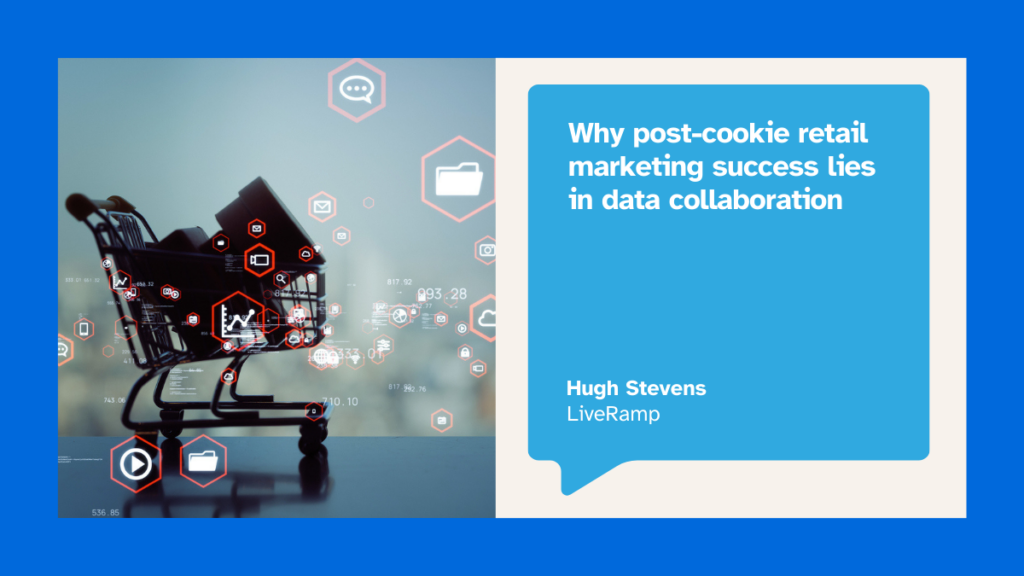By Hugh Stevens, UK MD, LiveRamp
Customers today engage with brands across a plethora of digital and physical touchpoints. A conversion that happened in-store may have had its inspiration come from that user browsing a digital shelf. Or it may have been the result of being exposed to an ad they were served whilst watching an advertising-based video-on-demand streaming service (AVOD).
Indeed, there is a wealth of omnichannel data out there from these interactions which, when made accessible to retail and FMCG marketers, can drive a range of use cases, whether that’s maximising conversions, to planning long-term brand objectives.
Uniting these datasets is, however, easier said than done. Fragmented across different businesses and digital environments, the customer insight available to businesses internally – that may have accrued through a loyalty scheme – is often siloed, and so its lucrative potential lies dormant.
Nevertheless, if marketers persevere and make this data correctly permissible across channels through data collaboration, it can be made addressable and unlock the insights the business needs to succeed. In particular, this can deliver the omnichannel, personalised, and relevant experiences that consumers appreciate and respond to.
At a time when the ecosystem is evolving from one built around the third-party identifier, to one that puts customer privacy at the forefront, without data collaboration, advertisers will find it much harder to obtain the insights, as well as streamlined activation and measurement, that powered their marketing. So, how can retailers and brands work together to navigate this shift, make first-party data actionable at each part of a consumer’s journey, and then measure its impact?
Challenges to data collaboration
Internal data silos are a big challenge for those looking to leverage data collaboration. Accumulating first-party data becomes meaningless if it can’t be used to effectively target and engage consumers. For example, internal e-commerce data often exists entirely separately from data generated by in-store operations. Data only becomes effective when it is structured in a way that can produce insights, and connected to be actionable against business objectives.
To get their first-party data house in order, brands should audit their internal data structures and ensure internal workstreams are aligned with democratising data. However, successfully unifying and consolidating this data, to achieve a customer-level view across all lines of touch, requires a more granular approach.
Moreover, no matter how much data you have internally, it’s impossible to have an end-to-end picture of the consumer by yourself. With scale being one of the biggest challenges facing advertisers in the ‘cookieless’ era, brands need to collaborate with multiple partners to have access to a meaningful amount of data and enable addressability. Thankfully, technologies like enhanced data clean rooms can ensure that addressable data is accessible across the organisation and, crucially, make it available to third parties in a privacy-sensitive way.
This technology also enables brands to retain tighter control of their data assets while unlocking more potential for data collaboration with partners. For example, in 2021, Boots was activating only 7% of its media budget based on first-party data. Today, however, close to 60% of the brand’s media spend is now guided by the use of first-party data in combination with select data collaborations with premium publishers and broadcasters.
Putting this into practice
The rapid growth of Commerce/Retail Media as a marketing channel provides an excellent illustration of how data collaborations between large retailers (with masses of up-to-date shopper and loyalty card data) and brand advertisers are starting to transform the advertising marketplace.
Inspired by the success of Amazon in establishing a highly lucrative advertising business, major UK retail brands have all established their own retail media networks in recent years. Brands, in turn, have responded enthusiastically. In a 2023 survey commissioned by LiveRamp, almost 60% of marketers questioned said that retail media was an important part of their plans. Indeed, the opportunity is particularly open for brands that are data-poor, which can make use of second and third-party data to bolster their audience profiles, expand targeting, and enable holistic attribution from exposure to purchase.
While retailers have been among the first to move on the opportunities of data collaboration, it is a developing field. So far, we have only scratched the surface of what’s possible in consumer, product, and partner innovation. It’s now a matter of employing the right expertise, whether that’s with internal teams or third-party partners, and championing individuals who can forge a sophisticated data collaboration strategy.
Data collaboration is a uniquely powerful way to build enduring brand and business value. Leading brands, media giants, retail innovators, and service providers are all using data partnerships to unlock incremental revenue, discover and activate new audiences, and expand reach.
As part of a wider industry shifting away from tracking toward privacy-centric methods, companies must embrace evaluating identity solutions, selecting solutions that improve interoperability, and connecting data to bring the customer into view no matter the touchpoint.
*LiveRamp is a client of Bluestripe Communications, owned by Bluestripe Group, publisher of NDA









